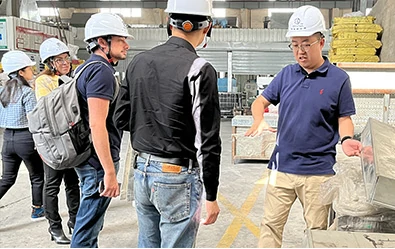loading...
- No. 9, Xingyuan South Street, Dongwaihuan Road, Zaoqiang County, Hengshui, Hebei, China
- admin@zjcomposites.com
- +86 15097380338
- Welcome to visit our website!
High-Quality FRP Railing Systems | Durable & Lightweight Solutions
Understanding FRP Railing Systems A Modern Solution for Safety and Aesthetics
In today’s construction and design landscape, the emphasis on safety, durability, and aesthetic appeal has led to the increasing popularity of Fiber-Reinforced Polymer (FRP) railing systems. These advanced materials offer a myriad of benefits, making them an ideal choice for various applications, from residential decks to commercial buildings and industrial environments.
What is FRP?
Fiber-Reinforced Polymer, commonly referred to as FRP, is a composite material consisting of a polymer matrix reinforced with fibers, typically glass or carbon. This combination results in a material that is lightweight yet incredibly strong, resistant to corrosion, and capable of withstanding harsh environmental conditions. These properties make FRP an excellent alternative to traditional railing materials such as wood, steel, and aluminum.
Key Advantages of FRP Railing Systems
1. Durability One of the standout features of FRP railing systems is their exceptional durability. Unlike wood, which can rot, warp, or splinter over time, FRP maintains its structural integrity, even in harsh weather conditions. This longevity significantly reduces maintenance costs and the need for frequent replacements.
2. Corrosion Resistance FRP is inherently resistant to chemicals, moisture, and UV rays, setting it apart in applications near water bodies or in chemical processing environments. This resistance prevents rust and corrosion, ensuring that the railing remains both functional and visually appealing over time.
frp railing systems

3. Design Versatility FRP railing systems can be molded into various shapes, colors, and designs, allowing for a high degree of customization. Whether for a modern urban loft, a traditional home, or an industrial facility, FRP can complement any architectural style while enhancing safety features.
4. Lightweight Nature The lightweight nature of FRP makes installation easier and more efficient than heavier materials. This attribute also reduces the load on structures, making it suitable for a broader range of applications, including high-rise buildings and bridges.
5. Environmental Sustainability As environmental concerns become increasingly prominent, the sustainability of building materials is in the spotlight. Many FRP products are made from recyclable materials, and their long lifespan contributes to reduced environmental impact.
Applications of FRP Railing Systems
FRP railing systems are suitable for a variety of settings, including residential balconies, commercial stairways, walkways, and even offshore platforms. Their robust characteristics make them appealing in sectors such as construction, marine, and transportation.
Conclusion
In conclusion, FRP railing systems offer a combination of strength, durability, and visual appeal, making them an excellent choice for modern construction and design projects. As the industry continues to evolve, embracing innovative materials like FRP will be crucial for achieving safe, sustainable, and aesthetically pleasing environments. Whether you're a builder, architect, or homeowner, considering FRP for your railing needs could prove to be a wise investment in the long run.
-
Revolutionizing Industrial Safety with ZJ Composites' Mini Mesh GratingNewsNov.14,2025
-
Premium FRP Profiles and FRP Grating Revolution for Global WholesalersNewsNov.14,2025
-
Ultimate Strength with ZJ Composites FRP Profiles for Wholesale SuccessNewsNov.14,2025
-
ZJ Composites Covered Grating – The Durable Flooring Solution for Smarter Industrial SpacesNewsNov.14,2025
-
Mini Mesh Grating Enhancing Strength and Style in Every ProjectNewsNov.14,2025
-
FRP Pressure Vessels by ZJ CompositesNewsNov.14,2025
-
Transforming Industrial Spaces with Advanced Frp GratingNewsNov.11,2025
